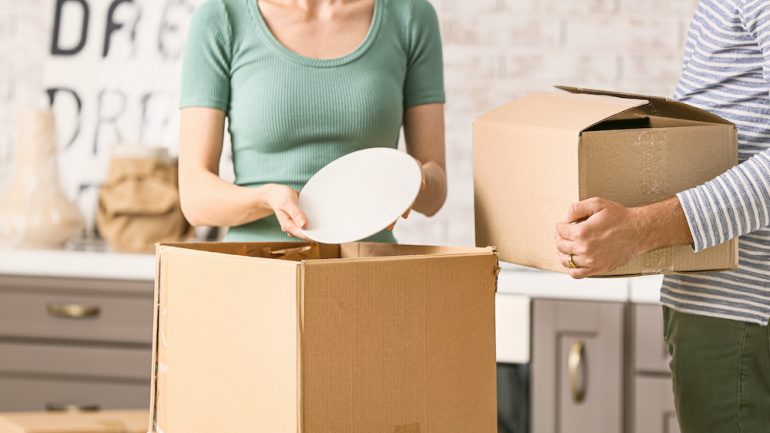Moving is hard, stressful work, and packing your kitchen may be the most difficult task of all. The kitchen has items that vary in size and degrees of breakability. You’ll need some of them as soon as you reach your new home. Food items may be perishable. It’s all a lot to take on. Here’s how to ease the stress of packing up a kitchen.
Start with a purge when moving your kitchen
Packing a kitchen offers an excellent opportunity to get rid of clutter. There’s nothing like moving to force you to decide what is — and isn’t — worth keeping. Since kitchens attract clutter, go through cabinets and drawers and purge anything that’s not worth the effort to move.
Pack daily essentials separately
During the transition between houses, you’ll need a few essentials, so pull and pack them first. In a separate box pack a plate, utensils, drinking glasses, and a coffee cup for each family member. Add an all-purpose pan, a microwave-safe dish for heating food, and any vital small appliances like a toaster. This box will serve your and your family’s needs until you unpack in the kitchen of your new home.
Packing materials
Moving companies can supply the different types of boxes and packing materials you will need.
When packing a kitchen, use heavier cardboard boxes, with thicker or double-layered cardboard, for transporting breakable dishware. A “dish barrel” box has heavy-duty sides and bottom and is made for stacking plates and bowls. You should also use heavier boxes to transport canned goods. Place cardboard partitions in heavy-duty boxes to keep bottles of oils, vinegars, wine, and liquor from banging against one another.
Lighter cardboard boxes can be used for pots and pans, cookie sheets, cooking utensils, dishware, cups and glasses, and miscellaneous items.
Although newspapers are an old standby for wrapping breakable items when packing a kitchen, you can get packages of plain paper from your mover for the same purpose. That way you won’t have to clean the items before putting them away.
Help breakables to survive
When packing breakables, start by lining the bottom of the box with a cushioning layer of crumpled packing paper. Wrap each dish, cup, or glass with two sheets of wrapping paper. Dishes should be centered on the paper sheets so the edges of the sheets can be wrapped up and over. Lay glasses and cups on their sides, then roll them in the paper, tucking the top of the sheets inside the item.
Put folded or crumpled layers of wrapping paper between each dish, cup, and glass. Stack breakable dishware, glasses, and cups with the heaviest on the bottom. Pack progressively lighter and more fragile items toward the top. Be careful not to overpack boxes. Stuff crumpled sheets of paper, bubble wrap, or Styrofoam peanuts in the empty spaces inside the box. If you can hear items clanking against each other, add more.
Now, where did we pack that?
When packing the home, write the room where a box goes on the outside with a notation of what’s inside. Better yet: List everything in the box on a sheet of paper, place the paper in an envelope, and tape it to the box.
Perishables
Use up or discard perishable refrigerated foods before the move. Take only the food that is essential, and pack it in a cooler with ice or cold packs.
There are services that will pick-up pantry and perishable foods for donation to a food bank or pantry. Some moving companies may even handle this for you.
Appliances
Your mover will wrap your large appliances in either moving blankets or shrink wrap. Add a layer of cardboard to visible sides, such as the front of the refrigerator, as insurance against scratches and dents.
You should wrap your small appliances such as toasters and mixers in paper and pack them in heavy-duty boxes with padding between them.
Related – Do-It-Yourself Packing and Moving


